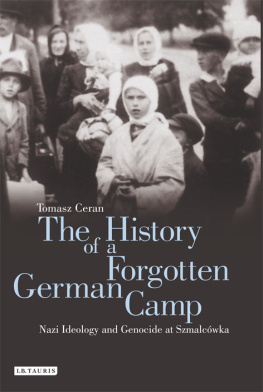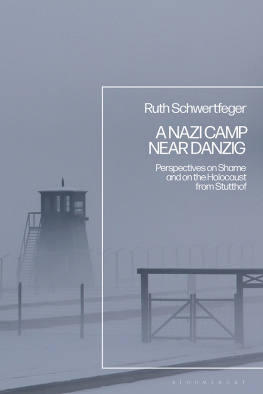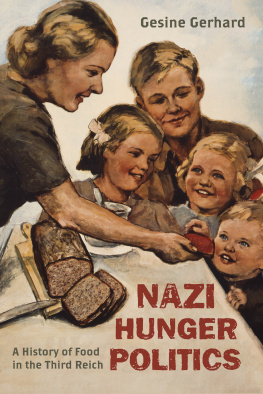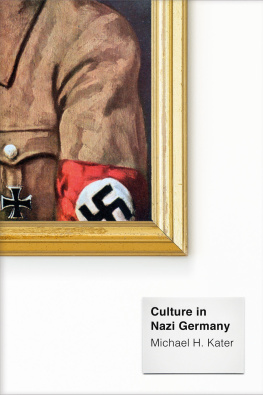Tomasz Ceran is a Polish historian who works for the education and research branch of the Institute of National Remembrance, Poland. He holds a PhD from Nicholas Copernicus University, Toru.
Published in 2015 by I.B.Tauris & Co Ltd
6 Salem Road, London W2 4BU
175 Fifth Avenue, New York NY 10010
www.ibtauris.com
Distributed in the United States and Canada
Exclusively by Palgrave Macmillan
175 Fifth Avenue, New York NY 10010
2015 Tomasz Ceran
The right of Tomasz Ceran to be identified as the author of this work has been asserted by the author in accordance with the Copyright, Designs and Patents Act 1988.
All rights reserved. Except for brief quotations in a review, this book, or any part thereof, may not be reproduced, stored in or introduced into a retrieval system, or transmitted, in any form or by any means, electronic, mechanical, photocopying, recording or otherwise, without the prior written permission of the publisher.
Every attempt has been made to gain permission for the use of the images in this book. Any omissions will be rectified in future editions.
ISBN: 978 1 78076 886 1
eISBN: 978 0 85773 553 9
Genocide and Holocaust Studies I
A full CIP record for this book is available from the British Library
A full CIP record is available from the Library of Congress
Library of Congress Catalog Card Number: available
Any violence which does not come from a strong spiritual base, will be wavering and uncertain. It lacks the stability which can only rest in a fanatical outlook.
Adolf Hitler, Mein Kampf
And here we found ourselves in hell.
Janina Filipek, whose daughters died in the camp nine-month-old Wadysawa and three-year-old Wiesawa as well as her mother-in-law, seventy-one-year-old Anna
Bloody hell! Why so few? Damn Polish pigs! More of them should drop dead ...
Dohbert, a guard at the Toru camp, on discovering that three prisoners had died during the night
Youre a good mother. I must have told you this before but, if you werent a Pole, I would make you an example to German mothers.
But you are a Pole, and therein lies your entire problem.
Willy Ehlert, commander of Szmalcwka to Wanda Klimek, prisoner
LIST OF TABLES AND FIGURES
Tables
The number of prisoners in the camp
Percentage of people unable to be sent to work
The number of people sent from the camp in Toru to the Germanization camp in d in the years 19412
Statistics of diseases suffered by prisoners
The list of names of Polish people who died in the camp
Figures
Components of the Nazi worldview
The Greater Germanic Reich according to Karl Haushofer
Joseph Goebbels visits Bydgoszcz (Bromberg), November 1939
The location of Szmalcwka
Map of the camp
The area from which the prisoners were sent to the camp
Sketches of the camps quarters covered with straw
Sketches of the camps washroom
Willy Ehlert third commandant of Szmalcwka (FebruaryOctober 1942)
The number of people who died in the camp according to age
The number of children and adolescents who died in the camp according to age
Teddy bear on one of the childrens graves in the cemetery at Grudzidzka Street in Toru. (Tomasz Niklas)
ACKNOWLEDGEMENTS
Familiarizing the English-language reader with this slice of Polish World War II history has been made possible thanks to the generosity and support of some wonderful people. Professor Jerzy Borejsza from the Institute of History of the Polish Academy of Sciences developed my historical imagination by setting me tasks that were always slightly above my ability, always believing in me. I am immensely grateful to him for the faith he showed in me. I have spent many hundreds of hours discussing life, science and history with Professor Pawel Hanczewski of Nicolaus Copernicus University in Toru. I wish to thank him for these stimulating conversations and, rather greedily, ask for more. Professor Miroslaw Golon from the Institute of National Remembrance in Gdask inspired me to study this subject. This book would not have been written had it not been for the selfless help of Professor Harry Dickinson of the University of Edinburgh, whose way of writing and thinking about history is very close to mine. I am also deeply indebted to Joanna Godfrey, senior editor of I.B.Tauris, who showed such trust in me and shared my belief in the importance of bringing the story of the Polish children of Szmalcwka to a wider readership. In addition, I must express my profound gratitude to Casimir Pulaski translator Justyna Pado for the sterling work she did and Dr Isabela Mazanowska for her invaluable support.
It is my belief that history, apart from being about the pure acquisition of knowledge, can and should fulfil a social function: namely, the teaching of empathy. This history of the German resettlement camp in Toru was created during a particular period of my life. The Polish-language version of this book was written at the Institute of National Remembrance when my son, Mikolaj, was being born. The English-language version was created at the same time as the birth of Dominik. Paraphrasing the words of the prisoner from Szmalcwka contained in the introduction to this book, I hope that they and their peers (on both sides of the Oder!) will quickly learn the beauty of the world around us and experience a great deal of goodness and kindness from the people around them.
Finally, I would like to thank my wife, Agnieszka, who is always with us to fill our lives with love and optimism. Everything else, from my perspective, is of secondary importance.
INTRODUCTION
We learnt early on the nightmare of the world around us and the tragedy of what a man, declaring himself a superman, was able to do to another man.
Henryk Wlodzimierz Klimek
The medieval city of Toru in the north of Poland, the birthplace of famous astronomer Nicolas Copernicus, is visited every year by nearly 1.5 million tourists. The visitors admire impressive Gothic public and private buildings, including three churches and the elegant medieval town hall, that gave the city a place on the UNESCO World Heritage List. Not far from the busy city centre, at the intersection of Kozacka Street and Grudzidzka Street, there is a small memorial of national remembrance, a three-metre section of red brick wall. The plaques placed on it commemorate those Polish civilians who died in the Nazi resettlement camp. Next to the restaurant there is Municipal Cemetery No. 2 of the Victims for World War II, where the prisoners were buried. This is how the past meets the present.
The history of the Nazi resettlement camp in Toru and its educational work is just a small part of the German occupation policy in the Second Polish Republic. The history of Szmalcwka is of interest almost exclusively to regional historians and those who want to remember. Just as Barbarka (who blackmailed Jews that were hiding, or Poles who protected Jews during the Nazi occupation translators note) rather than with the German camp in Toru.
The name of the camp is frighteningly symbolic. Placing the Polish population in this former factory of lard and oils, which before the war was owned by a Polish Jew, symbolically reflects the attitude of the German master race to the Slavs, including the Polish sub- humans. British historian Martin Gilbert, in one of the most popular syntheses of World War II, mistakenly included Szmalcwka (the Toru lard factory) within the group of direct extermination camps created in the autumn of 1939 in the Gdask Pomerania region. He was not, however, mistaken when he called the fat factories in Toru one of the first symbols of German barbarism, a place designated for the execution of Poles.






